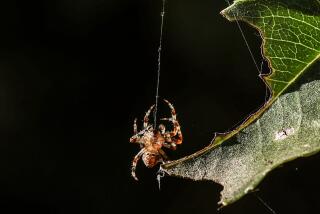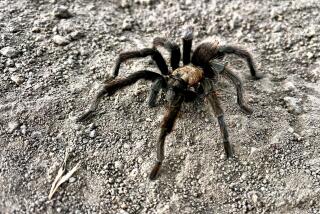The Case of the Puppet Spiders
It’s become a standard plot line in science fiction: An alien parasite infects the brain of a hapless victim and slowly converts its host into a slave.
Biologists, though, have long known they need not look to outer space for examples of such horrifying behavior. The latest case in point comes from deep in the Costa Rican rain forest.
William Eberhard, a biologist at the University of Costa Rica and the Smithsonian Tropical Research Institute, studies web construction by the Frank Lloyd Wright of spiders: the orb weaver. He was examining webs when he came across a few he just couldn’t understand.
Instead of archetypal rounded and orderly webs, he found small, rectangular webs attached with unusually strong silken cables. Each disfigured web held a bright orange cocoon in the center. Eberhard was astounded to see spiders constructing them.
“I really know their behavior, and these guys were doing something really weird,” he recalled in a telephone interview from Costa Rica. “They . . . were doing the wrong thing.”
What Eberhard observed was unlike anything he’d seen before: Parasitic wasps were using the spiders as day care for larvae.
An adult wasp would attack a spider and glue an egg onto the victim’s abdomen. The larva would then apparently inject a chemical into the unwitting spider’s bloodstream that somehow triggered the odd web-weaving behavior.
For what purpose? The super-strength web “is in the best interests of the wasp larva,” Eberhard said. In webs with less heavily reinforced lines, larvae might be knocked to the ground in heavy rain.
A Strange Departure in Web Design
As Eberhard watched, he would see a wasp hunting on the wing--stinging the colorfully streaked spider, even as the spider attempted to jump or run across the web. “It was sad,” he said. “The spiders are pretty helpless.”
The sting would paralyze the spider, allowing the parasitic wasp to glue on the egg. The spider would then wake up, shake off its grogginess and go about its normal life for a week or more, constructing normal webs and catching prey.
The spider seemed unaware of its charge even as the larva drilled holes into it and sucked its blood. “You don’t see any response from the spider,” he said.
On the spider’s final night, it would suddenly start spinning the strange cocoon web--in response, Eberhard surmised, to the chemical the larva dumped into the spider’s blood.
The spider would work diligently for as much as an hour, making the oddly shaped web.
Once done, the spider would sit quietly in the center of its web. Within half an hour it would be dead, apparently poisoned by the larva. It is unknown how a larva orchestrates this precision timing, or how it even knows when the spider has finished creating the web well-suited for the parasite.
The larva would then suck the spider dry, discard the husk and, all business, spin its own cocoon.
In a few days, the wasp would emerge from its cocoon and fly off to find a mate. In a few more days it would return, seeking fresh spider day care for its own young.
Because the wasp larva hijacks the complicated web-building behavior of the spider, Eberhard’s observation is seen as a dramatic example of how a parasite can alter a host for its own needs. He described the finding in a recent issue of the journal Nature.
“It’s really good scientific natural history,” said Charles Godfray, an expert on parasite behavior at Britain’s Imperial College at Silwood Park. While there has been much interest in how parasites alter the behavior of their hosts, Godfray said there are few well-documented examples.
Another parasite expert, Hilary Hurd of Britain’s Keele University, agreed. “It would be nice if this could be explored further,” she said. Still, she said, she found
the idea that the parasite was directing the spider’s behavior convincing. “It’s timed very precisely to match the needs of the parasite.”
Studying parasites--and how they make their way in the world of living hosts--is crucial ground for biologists, who see them as the key to understanding the biological
arms races that can speed the evolutionary process.
One question parasitologists always ask is whether the host is behaving differently merely because it has been sickened by the
parasite. But Eberhard, a veteran spider watcher, said that’s clearly not the case here.
“I expected I might see a spider staggering,” he said. “What I saw was energetic,
normal behavior. They are not moving slowly or looking sickly.”
The only change he noticed was that spiders would pause after 10-minute bouts of web building; normally they build continuously for 20 to 30 minutes to finish a web.
He believes the spiders are building normally but omitting key steps of the process. For example, the affected spiders don’t add the adhesive strands that make up the bulk of a normal web.
Normally the spiders, which rely on webs to capture prey, also finely adjust tension on web lines by laying lines, checking them and absorbing them if they are too tight or too loose.
But those affected by parasites omit that step. Webs built solely to support cocoons apparently don’t require such fine-tuning.
Eberhard is now busy trying to isolate any chemicals the wasp larva might be injecting into the spider to alter its behavior. He’ll then be able to examine the system more closely in the lab.
To Eberhard, the killer wasp larva has become an unlikely scientific ally. By fiddling with the spider’s web-building capability--making the arachnid leave out several steps but repeat others--the wasp is helping dissect web-building behavior.
“Basically,” said Eberhard, “the wasp is telling us something about how orb webs are constructed.”
*
The author may be contacted at [email protected].
(BEGIN TEXT OF INFOBOX / INFOGRAPHIC)
Slave Labor
A spider expert in Costa Rica recently discovered this dramatic example of one animal’s hijacking the behavior of another. Many parasites lay eggs in other animals; the young often go on to eat their hosts. In this case, the larva of a parasitic wasp apparently alters the behavior of a spider so it builds a web tailor-made for a cocoon. Only when the spider has completed that task is it killed.
1) Wasp hunts and stings spider to paralyze it.
2) Wasp lays egg on spider’s abdomen.
3) For 7-10 days, spider goes about normal business, spinning new webs and catching prey.
4) On final night of spider’s life, it spins a strange cocoon web.
5) When spider is done, larva kills it, sucks it dry and discards it. Larva then makes bright orange cocoon and pupates.
6) Adult wasp hatches, goes off to mate and then returns-- looking for new spider victim.
Source: Eberhard, Smithsonian Tropical Research Institute
More to Read
Sign up for Essential California
The most important California stories and recommendations in your inbox every morning.
You may occasionally receive promotional content from the Los Angeles Times.










